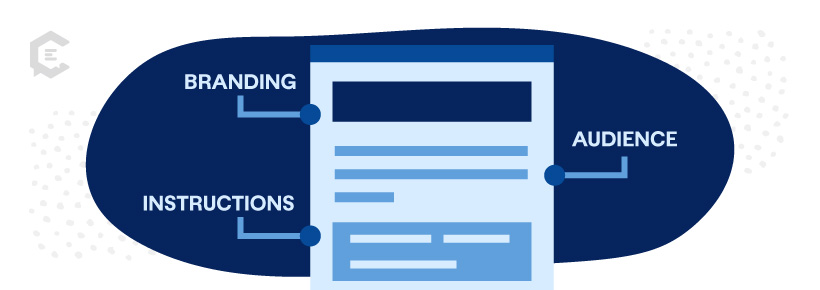As any architect will tell you, a blueprint is integral to constructing a building that stands the test of time. In the realm of content creation, this blueprint comes as a well-constructed brief. More than a mere collection of instructions, a comprehensive brief serves as the guiding compass that steers freelance writers through your brand’s distinct identity, the demographics, the needs of your audience, and your project’s unique specifications.
A brief is the first step toward building content that not only meets your requirements but truly captures your vision.
Drawing from ClearVoice’s extensive experience managing tens of thousands of pieces of content for diverse clients, ranging from small and medium businesses to large enterprises, this guide is designed to be a masterclass on crafting briefs that lead to optimal content creation.

The Impact of a Well-Constructed Brief
A well-constructed brief has transformative potential. It catalyzes efficient and successful content production and goes beyond the immediate task by nurturing a collaborative environment conducive to creativity and high-quality content output.
But to even get close to this euphoria, you need to ensure the following:
Ensuring Understanding
At its core, a brief is a tool for conveying expectations and goals. It deciphers the unique dialect of your brand and communicates it to freelance writers in a language they understand. By doing this, a brief ensures that your freelancers are not just writers for your brand but active collaborators who share your vision.
In defining your content objectives, you equip writers with the necessary insights to tailor their content to align with your strategies. This can include anything from your brand’s voice and style to the purpose of the content – whether it is intended to inform, entertain, or persuade your audience. Thus, an effective brief bridges the gap between your brand’s vision and the writer’s understanding, ensuring the produced content hits the mark.
Streamlining the Writing Process
An effective brief also serves as a roadmap, guiding writers through content creation. With clear directions, writers can navigate the path from the initial idea to the final piece with fewer detours, reducing wasted time and effort on misunderstandings or misinterpretations.
By laying out the key points to cover, the desired tone of voice, the intended audience, and any specific research or references required, a brief can help streamline the writing process. This helps maintain consistency across various pieces of content and significantly reduces the need for major revisions. Consequently, an efficient workflow is established, allowing for quicker turnaround times and increased productivity.
Nurturing a Productive Relationship
But perhaps the most profound impact of a clear, comprehensive brief is its ability to foster a more positive, productive relationship with freelance writers. A good brief establishes a mutual understanding between you and your writers. It clearly conveys that you respect their time and effort, reinforcing their motivation to deliver their best work.
Furthermore, clarity in the brief can reduce back-and-forths and misunderstandings, allowing for a smoother collaboration. This not only saves time but also helps build a strong, long-lasting working relationship with your freelancers. They become familiar with your brand, style, and expectations, making them even more valuable content team members. In this sense, an effective brief is not just a project tool but a relationship builder.

The Anatomy of a Great Freelance Writer Brief
An impactful freelance writer brief is more than a simple set of instructions. It is a nuanced document that provides writers with the necessary context and guidelines to create content that resonates with your audience and aligns with your brand identity. Here’s a deeper look into the essential components of a high-quality brief.
Defining Your Brand and Goals
Understanding the essence of your brand and communicating it effectively is the starting point for any brief. This is where you set the tone and lay the groundwork for the content to be created.
Brand Voice and Style
Your brand voice is your brand’s personality, and it must remain consistent across all content. Be clear about your brand voice in the brief — professional, conversational, authoritative, friendly, or a mix of several elements. Also, detail any specific stylistic guidelines the writer should adhere to, such as active voice, a particular writing style, or a preferred format.
Content Objectives
Next, clearly articulate the purpose of the content. Is it to inform, persuade, entertain, or generate leads? The content’s goal will influence its tone, structure, and language. Additionally, detail any specific calls to action or key messages the content should include.
Audience Understanding
To create content that resonates, writers need a clear understanding of the target audience.
Audience Profile
Describe your audience. Include demographics, psychographics, behaviors, and preferences. The more detailed the profile, the better the writer can tailor the content to speak directly to them.
Audience Needs and Expectations
What are the pain points, interests, or queries of your audience? What type of content do they find valuable or engaging? This information guides the writer in creating content that meets your audience’s needs and exceeds their expectations.
Content-Specific Instructions
The final component of a robust brief is the content-specific instructions, which serve as the roadmap for the writer.
Topic and Angle
Clearly state the topic of the content and the angle or perspective from which it should be addressed. Also, guide the structure and format, whether a blog post, listicle, or long-form guide.
Keywords and SEO Strategy
Include your target keywords and any pertinent details about your SEO strategy. Inform the writer about keyword placement, usage frequency, and other SEO elements like meta descriptions or title tags.
Required Research or References
Finally, detail any research or references the writer needs to include. If necessary, provide links to reliable sources, industry reports, or internal data. By providing these resources, you ensure that the content is well-informed but also credible and accurate.
Techniques for Crafting an Effective Brief
Writing a brief is an art in itself. To create a detailed yet concise brief, clear yet comprehensive, one needs to balance many elements. Whether using bullet points for easy readability or including visual examples for clarity, we delve into practical tips that make your brief truly effective.

Evaluating and Improving Your Briefs
Even the most seasoned professionals leave room for improvement. Learn how to evaluate the effectiveness of your briefs and tweak them for better results.
Just as the content created from your briefs requires continual evaluation and refinement, so do the briefs themselves. They should not be seen as static documents but as tools that need to be honed and enhanced over time. Here’s how you can assess the effectiveness of your briefs and make the necessary improvements:
- Review the Final Content: One of the most direct ways to assess the effectiveness of your brief is by reviewing the final piece of content. Does it align with your brand’s voice and objectives? Does it effectively address the audience’s needs and expectations?
- Gather Writer Feedback: Feedback from the freelance writers themselves is a valuable resource for improving your briefs. Their insights can help you identify blind spots and areas of confusion in your briefs.
- Analyze Content Performance: Use key performance indicators (KPIs) to gauge how well the content performs against your stated objectives (i.e., average time on site, bounce rate, engagement rate, etc.). This can help you determine if your brief successfully guided effective content creation.
- Implement A/B Testing: A/B testing is useful for evaluating different elements of your briefs. You could create two slightly different briefs for similar assignments and compare the resulting content. This approach can reveal which instructions or details yield better content and should be incorporated into your briefs more consistently.
- Embrace Iterative Improvements: Embrace an iterative improvement process, refining your briefs based on continual feedback, performance analysis, and A/B testing. You will ensure your briefs evolve and adapt to deliver the most effective results for your content projects.
Master your briefs for optimal content creation
As you continue your journey in content creation, remember that your brief is your first step. A well-constructed brief is instrumental in ensuring successful content output, efficient workflow, and a smooth operation of your content projects. As you master the art of briefing, you’ll unlock a higher standard of content and a more harmonious collaborative relationship with your freelance writers.
For more guidance on content creation and strategy, explore ClearVoice’s range of managed content creation solutions and sign up for a content strategy session today.



